| Spirituality and Mental Health: My Learnings on Resilience after Mass Trauma in Haiti By Dr. Beth Hedva, Director of Training, Finkleman Communications, Calgary, Canada www.drbethhedva.com |
(Photos: Beth Hedva's training programs turn out new recovery workers for Haiti)
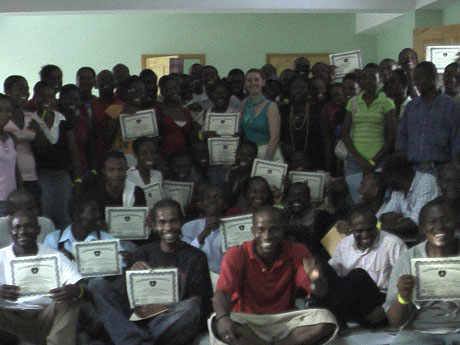
Emergency Volunteers and Social Science Students from the State University of Haiti
| Psychological
writings note that spirituality or religious beliefs can
help promote stability – which help create an environment that fosters
community cohesion and a sense of connectedness or resilience in times
of trauma. Some research (Chen, 2006) more specifically suggests that
religious belief or spiritual practices promote resilience by providing
‘meaning’ in times of adversity. After the January 2010 earthquake and aftershocks wracked Haiti, leaving 250,000 dead and 2 million homeless (Carroll, Addley, & Meikle, 2010) and or orphaned (Reinl, 2010), I was invited to work there under the auspices of the Association for Trauma Outreach and Prevention together with the local Haitian Daughters of Wisdom. During three weeks my key tool was a 5 step Spiritually Directed Protocol for Recovery From Trauma(2006)3 “Emotional Healing and Community Renewal Training Program”, which I had previously developed at the request of the Indonesian Psychology Association, blended with a group therapy model for healing from mass trauma (Kalayjian, 2009). |
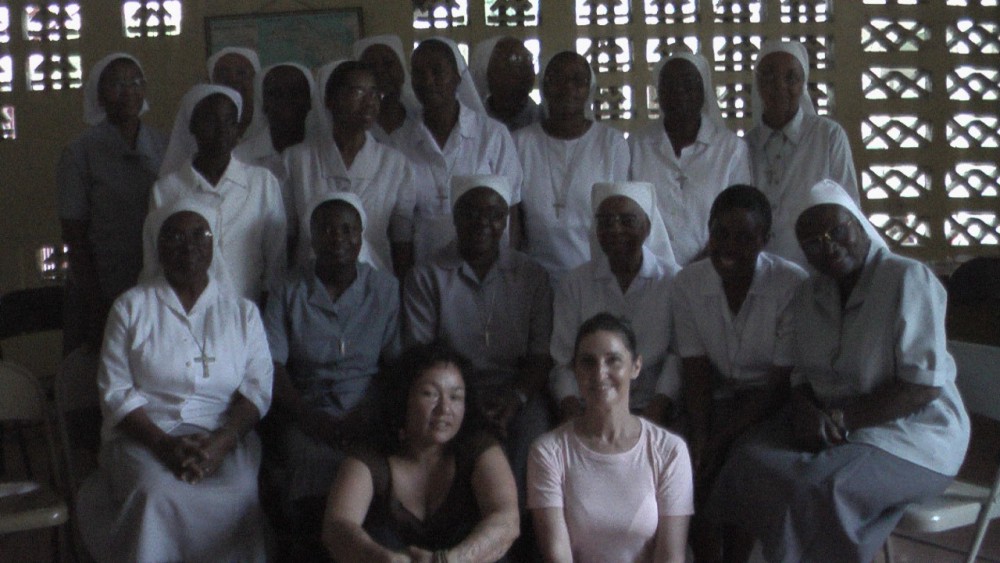
Daughters of Wisdom with Kim Haxton & Dr. Beth Hedva
| I had
employed my 5-Step program when training Indonesian recovery
workers, survivors and psychologists after the 2004 tsunami. In
Haiti,
training materials were donated by The Canadian Institute for
Transpersonal and Integrative Sciences and CEU’s were provided by and
made available through CCPA/L’ACCP continuing education programs. The
team included me, 1st Nations, Ceremonialist, Kim Haxton, and
Haitian
born Canadian Vlad Lubin, who acted as our translator and photographer.
Together we trained 275 local volunteers: 25 nuns, 60 social
science
students from the State University of Haiti, 170 teachers K-12, all of
whom were in some form also victims of the disaster.
Additionally, we
provided counselling to over 100 patients (children and adult
survivors) using play therapy and psychosocial crisis counseling
groups. Training was provided in group settings or one-on-one. It began and ended with the experience of connecting with spiritual healing energies and stress release using breath work. Next individuals were given a simple 10 question assessment (supplied by Doctors Without Boarders) so survivors could assess for themselves their degree of somatic, cognitive and emotional traumatic stress. This was followed by sharing personal stories of the event, including expressing feelings, especially stressful emotions, and seeking insight, personal meaning or lessons learned. Counselors were trained to empathize and validate feelings and provide psycho-education about disaster recovery, including how to reestablish balance within oneself (between body, heart, mind and spirit); with others (in interpersonal relationships) and with one’s environment (including the ecosphere). |
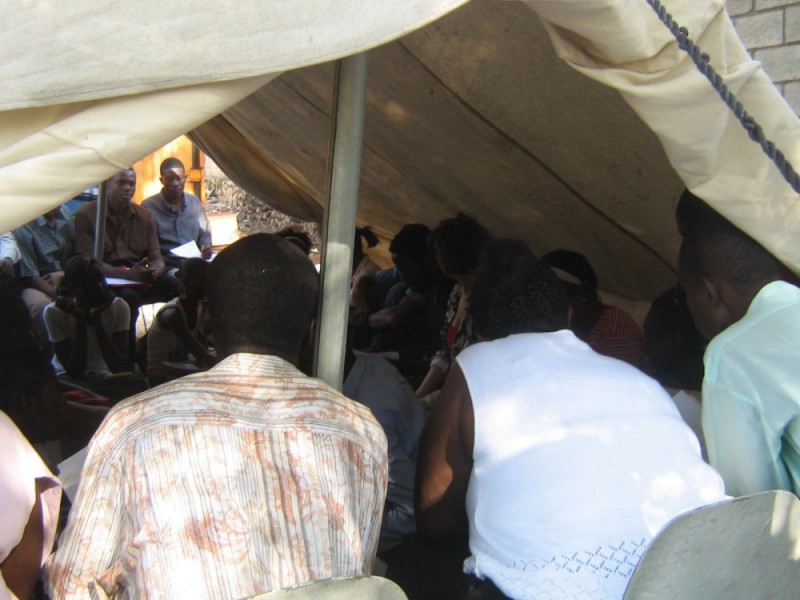
Teaching in a tent
| The counselor also described
four universal and cross- cultural healing
methods (Arrien, 1993): song, dance, story-telling and silence (as with
prayer and meditation) and asked each group member to demonstrate and
or share a story, poem and/or prayer, as an expression of feelings or
new learning. Everyone was invited (but not forced) to share. Survivors
were asked how they feel (in the ‘here and now’) and what they have
learned about themselves and the human condition after all our
sharing. The session would close with a final review: description of what one has learned, what worked best for them, how one will apply this learning (as ‘cognitive-behavioral homework’). They are then invited to become “leaders – to lead by example.” The final round of sharing is based on responding to the questions “name one thing you learned that you can share with others that may help others heal. . .” 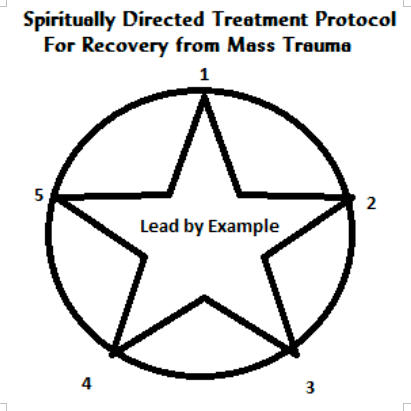 2. OBSERVE (and assess) Experiences of shock, crisis, grief/mourning, insight/resilience in self and others 3. LISTEN with the ears of your heart. Share stories and encourage authentic expression of self and others 4. TRAIN to engage creativity and intuition to gain insight, value, meaning / healing 5. EMPOWER self and others to lead by example. Practice and share new learnings. (Spiritually Directed Therapy Protocol, Hedva, 2006) I was especially inspired by the survivors I worked with in their ability to easily access and express expanded spiritual states of consciousness even in the midst of the crisis phase of the trauma. A desire to help others, and share both painful feelings as well as states of joy and peace inspired through story-telling, singing, dance and prayer, all indicated to me how very important it is for people to remember the beauty of the human spirit, and to confirm its presence as a resource for healing self and others. Two illustrative examples from survivors I worked with: the first, a young woman age 20, who spent two days under the rubble before being rescued; and the second, a nun in her late 30’s, who spent 20 hours under the rubble before rescue. After one group training, and only three individual sessions over three weeks, both had significant decreases in traumatic reactions as measured by the 10-point acute traumatic stress questionnaire (see results). The first survivor (2 days under rubble) used prayer (passages from Isaiah, and Proverbs 3:13-18 “Woman of Valor”) for healing between the first and second session. |

| In the second
session, she allowed what she felt was God’s presence
to guide her healing and, like Isaiah, she conferred with that presence
to give her guidance on ‘why’ she had survived. I anchored this
experience of health and healing using a modified Eye Movement
Desensitization Reprocessing (EMDR) therapeutic technique to further
integrate the inner sense of peace and her feeling of God’s
presence.
The second survivor, the nun, used the memory of dancing. I
combined
this experience of with spiritual healing techniques (‘laying on of
hands’) and other self-healing methods together with the modified EMDR
to anchor and integrate the experience of joy as a source of healing to
encourage resilience and overcome traumatic reactions. I learned again and again that engaging each survivor with one’s own experience of expanded spiritually healing states, such as peace, joy, faith or optimism, as guided by one’s personal religious, cultural or spiritual history, together with stress-reduction techniques, information on disaster recovery preparation and ‘leading by example’ (i.e. helping others heal) was a foundation for personal and community renewal in the Haitian culture. After this, invaluable self-understanding of one’s experience could be passed on to help heal others. |
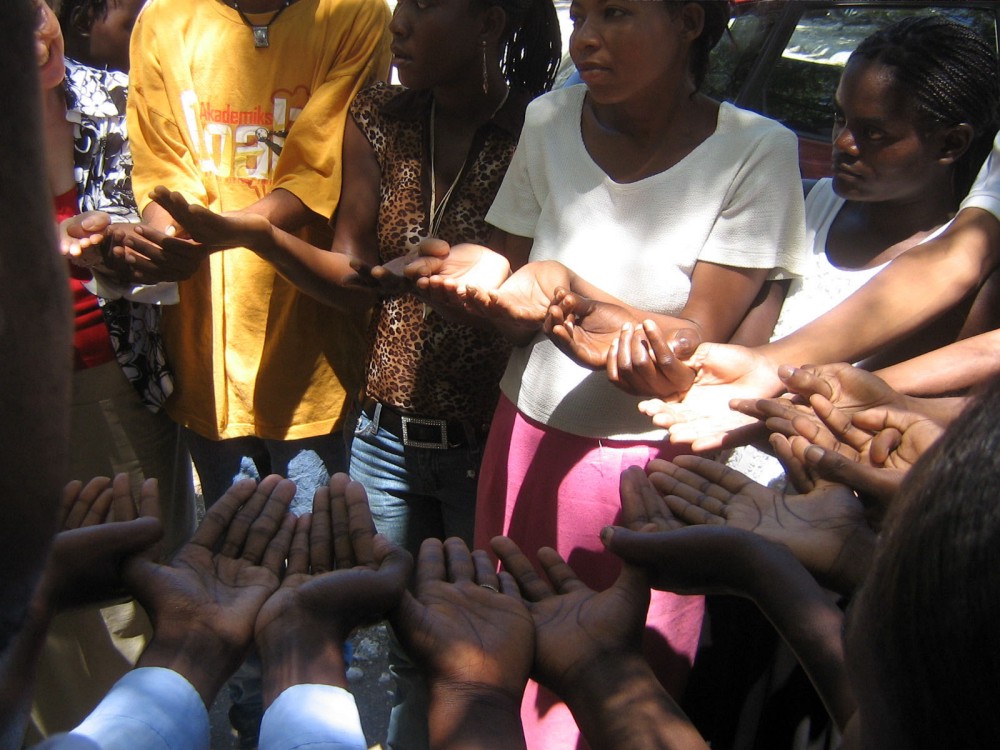
Thumbs enjoined, Beth Hedva shares healing circle with survivors
| References Arrien, A. (1993). The Four-Fold Way: Walking the paths of the warrior, teacher, healer, and visionary (1st ed). Harper One. Carroll, R.; Addley, E.; & Meikle, J. (2010). Haiti homeless reach 2 milion. Retreived for the website of guardian.co.uk, on Thursday 21 January 2010 at 12.20 GMT: http://www.guardian.co.uk/world/2010/jan/21/haiti-homeless-reach-2-million Chen, Y. Y.; Koenig, H. G. (September, 2006) Traumatic stress and religion: Is there a relationship? A review of empirical findings. Journal of Religion and Health, Volume 45, Number 3. Pp 371-381. Springer Netherlands D’ Souza R.F. R. (2004) A Spiritually augmented cognitive behavioral therapy. Australian Psychiatry, Retrieved on 21st of January 2010 from: http://www.guardian.co.uk/world/2010/jan/21/haiti-homeless-reach-2-million Hedva, B. (2008). Addressing psychic and spiritual disturbances using transpersonal, clinical and counseling techniques. The Heart of Asia Proceedings, p. 1-10, 2008. Hedva, B.; Arman, E., & Finkleman, H. (2009). Cultural Counselling Issues: Transpersonal and Clinical Counseling Training for Recovery Workers and Psychologists in Post Tsunami Indonesia (Pp 151-178). In Kalayjian, A. and Eugene, D. (Eds): Mass Trauma and Emotional Healing Around the World: Rituals and Practices for Resilience and Meaning-Making (Chapter 9, Volume 1) Preager Press. Kalayjian, A.; Moore N. & Richmond, K. (2009) Coping with the Earthquake in Pakistan: A Religio-Culturally Informed Treatment Vol 1, (pgs 55-71). Preager Press. Reinl, J. (2010) Haiti, home of a million orphans Retrieved on 23rd of January 2010 from:http://www.thenational.ae/apps/pbcs.dll/article?AID=/20100123/FOREIGN/701229837/1042/opinion |
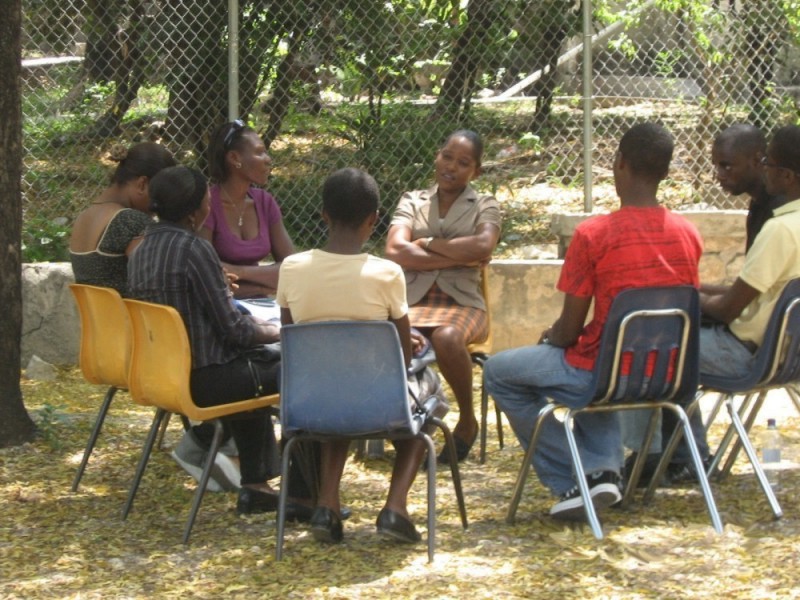
Here they are instructing school teachers who are dealing with some of the most vulnerable victims -- the children.